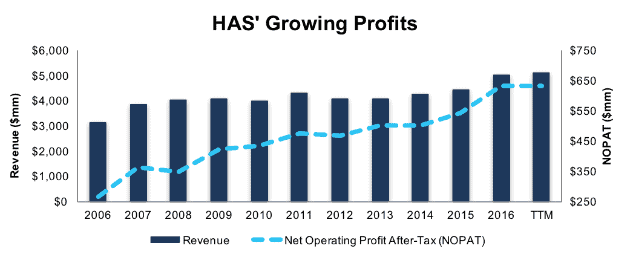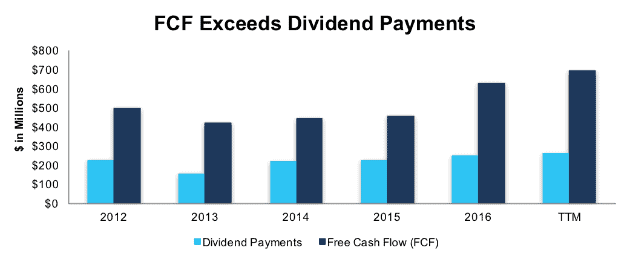This report highlights last month’s top performers and features a stock from the current portfolio. October’s Dividend Growth Stocks Model Portfolio was made available to members on October 26, 2017.
Recap from September’s Picks
Our Dividend Growth Stocks Model Portfolio underperformed the S&P 500 last month. The Model Portfolio rose 1.2% on a price return basis and 1.4% on a total return basis. The S&P 500 rose 2.0% on a price and total return basis. The portfolio’s best performing stock was Lennox International (LII), which was up 12%. Overall, 13 out of the 30 Dividend Growth Stocks outperformed the S&P last month and 17 had positive returns.
The long-term success of our model portfolio strategies highlights the value of our Robo-Analyst technology, which scales our forensic accounting expertise (featured in Barron’s) across thousands of stocks[1].
The methodology for this model portfolio mimics an All-Cap Blend style with a focus on dividend growth. Selected stocks earn an Attractive or Very Attractive rating, generate positive free cash flow (FCF) and economic earnings, offer a current dividend yield >1%, and have a 5+ year track record of consecutive dividend growth. This model portfolio is designed for investors who are more focused on long-term capital appreciation than current income, but still appreciate the power of dividends, especially growing dividends.
Featured Stock from October: Hasbro Inc. (HAS: $97/share)
Hasbro Inc. (HAS), global toy and game manufacturer, is the featured stock from October’s Dividend Growth Stocks Model Portfolio. HAS was also featured as a Long Idea in June 2017. The stock is down 11% since then (S&P +6%) and the lowered valuation creates an even better buying opportunity.
Over the past decade, HAS’ revenue has grown by 5% compounded annually while after-tax profits (NOPAT) have grown by 9% compounded annually, per Figure 1. HAS’s NOPAT margin has improved from 8% in 2006 to 12% over the last twelve months. Long-term, HAS has grown NOPAT by 7% compounded annually since 1998.
HAS’ return on invested capital (ROIC) (17% TTM) ranks in the top-quintile of our coverage universe and has improved from 11% in 2006.
Figure 1: HAS’ NOPAT Growth Over Past Decade
Sources: New Constructs, LLC and company filings
Steady Dividend Growth Supported by FCF
HAS has increased its regular dividend seven consecutive years and 13 times in the past 14 years. The current annualized dividend has grown from $1.44/share in 2012 to $2.28/share, or 10% compounded annually. Growing FCF has fueled dividend growth in the past, and we expect the same for the future. Over the past five years, HAS has generated cumulative FCF of $2.6 billion (20% of market cap) and paid out cumulative dividends of $1.1 billion.
Companies with FCF well in excess of dividend payments provide higher quality dividend growth opportunities because we know the firm generates the cash to support the current dividend as well as a higher dividend. On the flip side, the dividend growth trajectory of a company where FCF falls short of the dividend payment over time cannot be trusted to grow or sustain its dividend because of inadequate free cash flow.
Figure 2: HAS’ Free Cash Flow (FCF) vs. Regular Dividend Payments
Sources: New Constructs, LLC and company filings
HAS Remains Undervalued
Over the past three months, HAS is down 9% while the S&P is up 4%. This price decline gives HAS a more attractive risk/reward trade-off. At its current of $97/share, HAS has a price-to-economic book value (PEBV) ratio of 1.1. This ratio means the market expects HAS’ NOPAT to grow by no more than 10% over its remaining corporate life. This expectation seems overly pessimistic for a firm that has grown NOPAT by 7% compounded annually since 1998 and 9% compounded annually over the past decade.
If HAS can maintain current NOPAT margins (12% TTM) and grow NOPAT by 5% compounded annually over the next decade, the stock is worth $128/share today – a 32% upside. Add in Hasbro’s 2.3% dividend yield and history of dividend growth, and it’s clear why this stock is in October’s Dividend Growth Stocks Model Portfolio.
Auditable Impact of Footnotes & Forensic Accounting Adjustments
Our Robo-Analyst technology enables us to perform forensic accounting with scale and provide the research needed to fulfill fiduciary duties. In order to derive the true recurring cash flows, an accurate invested capital, and a real shareholder value, we made the following adjustments to Hasbro’s 2016 10-K:
Income Statement: we made $258 million of adjustments with a net effect of removing $80 million in non-operating expense (2% of revenue). We removed $169 million related to non-operating expenses and $89 million related to non-operating income. See all adjustments made to HAS’ income statement here.
Balance Sheet: we made $3 billion of adjustments to calculate invested capital with a net increase of $355 million. The most notable adjustment was $481 million (14% of reported net assets) related to asset write-downs. See all adjustments to HAS’ balance sheet here.
Valuation: we made $3.3 billion of adjustments with a net effect of decreasing shareholder value by $896 million. The largest adjustment to shareholder value was $1.9 billion in total debt, which includes $132 million in off-balance sheet operating leases. This lease adjustment represents 1% of HAS’ market value. Despite the decrease in shareholder value, HAS remains undervalued.
This article originally published on October 31, 2017.
Disclosure: David Trainer and Kyle Guske II receive no compensation to write about any specific stock, style, or theme.
Follow us on Twitter, Facebook, LinkedIn, and StockTwits for real-time alerts on all our research.
[1] Ernst & Young’s recent white paper “Getting ROIC Right” proves the superiority of our holdings research and analytics.


2 replies to "Featured Stocks in October’s Dividend Growth Model Portfolio"
You probably have heard the news already:
American Girl dolls sales dropped 30% year over year, stated a Marketwatch article on October 30. The company also suspended dividend payments for the 4th quarter. Thus, HAS should be taken off the dividend-growth list.
Why did you post this recommendation on October 31?
sorry, my post was about Mattel, not Hasbro. I hereby retract my last post.